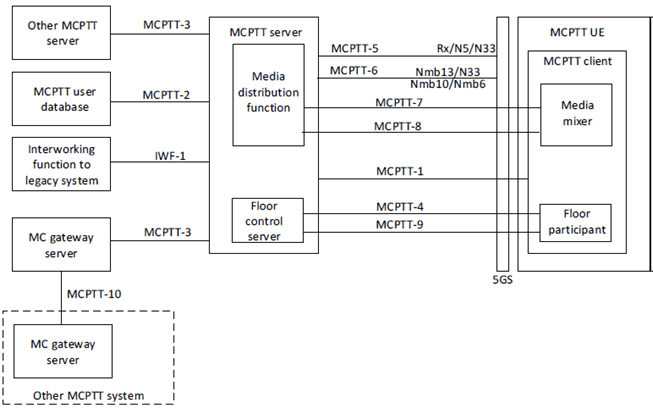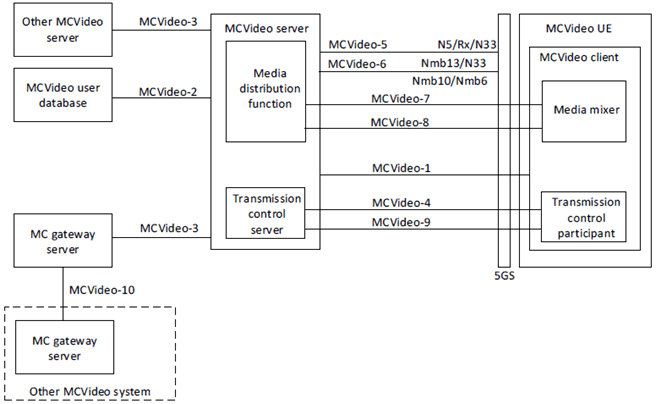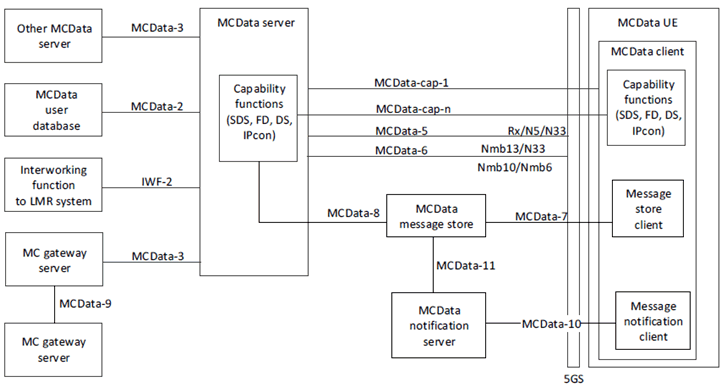Content for TS 23.289 Word version: 19.0.0
0…
4…
4.7…
4.7.4…
4.8…
5…
5.4…
6…
6.3…
6.3.2…
7…
7.2.4…
7.3…
7.3.3…
7.3.3.2…
7.3.3.4…
7.3.3.5…
7.3.3.7…
7.3.3.8…
7.3.3.9…
7.3.3.10…
7.3.3.11…
7.3.3.12…
7.3.3.13…
7.4…
7.5…
7.6…
A…
5.4 MCPTT functional model description
5.5 MCVideo functional model description
5.6 MCData functional model description
...
...
5.4 MCPTT functional model description p. 31
5.4.1 On-network functional model p. 31
Figure 5.4.1-1 shows the functional model for the application plane for an MCPTT system using the 5GS.

In the functional model shown in Figure 5.4.1-1, the following is considered:
- The description of the corresponding functional entities and reference points in TS 23.379 applies.
- MCPTT-1, uses the 5G-GC1 reference point as described in clause 4.7 and fulfils the requirements of the 5G-GC1 reference point for MCPTT.
- The description of the MCPTT-4 and MCPTT-7 reference points in TS 23.379 applies considering that it utilizes the N6 reference point defined in TS 23.501.
- The description of the MCPTT-5 reference point in TS 23.379 applies considering that it exists between the MCPTT server and the 5GS. It is used for resource management of MCPTT sessions, e.g. QoS control, and utilizes the N5 reference point or the Rx reference point or the N33 reference point as defined in TS 23.501, TS 23.502, TS 23.503 and TS 23.247.
- MCPTT-5, utilizing Rx reference point or N5 reference point, may be used when the MCPTT service provider directly interacts with operator's relevant 5GS network function for QoS control for both unicast PDU sessions and MBS sessions (if dynamic PCC is applicable).
- MCPTT-5, utilizing N33 reference point, may be used when the MCPTT service provider is limited by the operational agreement, i.e., indirect interaction with operator's 5GS network functions for QoS control.
- The MCPTT-6 reference point, which exists between the MCPTT server and the 5GS, is used to create an MBS session obtaining multicast or broadcast resources for MCPTT application usage.
- The MCPTT-6 reference point utilizes Nmb13 reference point when the MCPTT service provider and the PLMN operator have an operational agreement where QoS control is provided directly from the MCPTT service provider domain.
- The MCPTT-6 reference point utilizes Nmb10 reference point when MBSF is used.
- The MCPTT-6 reference point utilizes N33 reference point when the MCPTT service provider is limited by the operational agreement for QoS control, i.e. indirect interaction with operator's 5GS network functions for QoS control is only allowed.
- The MCPTT-6 reference point utilizes Nmb6 reference point when MCPTT service provider interacts with the Joint BM-SC, MBSF and MBSTF entity to facilitate interworking with LTE.
- For MCPTT-8 reference point, the reference point definition in TS 23.379 applies. The MCPTT-8 reference point utilizes the N6mb reference point according to TS 23.247.
- The MCPTT-8 reference point utilizes the Nmb8 reference point according to TS 23.247 when MBSTF is used.
- For interworking with LTE via Joint BM-SC, MBSF and MBSTF entity, the MCPTT-8 reference point utilizes the Nmb4 reference point according to TS 23.247.
- For MCPTT-9 reference point, the reference point definition in TS 23.379 applies. The MCPTT-9 reference point utilizes the N6mb reference point according to TS 23.247.
- The MCPTT-9 reference point utilizes the Nmb8 reference point according to TS 23.247 when MBSTF is used.
- For interworking with LTE via Joint BM-SC, MBSF and MBSTF entity, the MCPTT-9 reference point utilizes the Nmb4 reference point according to TS 23.247.
5.5 MCVideo functional model description p. 32
5.5.1 On-network functional model p. 32
Figure 5.5.1-1 shows the functional model for the application plane for an MCVideo system using the 5GS.

In the functional model shown in Figure 5.5.1-1, the following is considered:
- The description of the corresponding functional entities and reference points in TS 23.281 applies.
- MCVideo-1, uses the 5G-GC1 reference point as described in clause 4.7 and fulfils the requirements of the 5G-GC1 reference point for MCVideo.
- The description of the MCVideo-4 and MCVideo-7 reference points in TS 23.281 applies considering that it utilizes the N6 reference point defined in TS 23.501.
- The description of the MCVideo-5 reference point in TS 23.281 applies considering that it exists between the MCVideo server and the 5GS. It is used for resource management of MCVideo sessions, e.g. QoS control, and utilizes the N5 reference point or the Rx reference point or the N33 reference point as defined in TS 23.501, TS 23.502, TS 23.503 and TS 23.247.
- MCVideo-5, utilizing Rx reference point or N5 reference point, may be used when the MCVideo service provider directly interacts with operator's relevant 5GS network function for QoS control for both unicast PDU sessions and MBS sessions (if dynamic PCC is applicable).
- MCVideo-5, utilizing N33 reference point, may be used when the MCVideo service provider is limited by the operational agreement, i.e., indirect interaction with operator's 5GS network functions for QoS control.
- The MCVideo-6 reference point, which exists between the MCVideo server and the 5GS, is used to create an MBS session obtaining multicast or broadcast resources for MCVideo application usage.
- The MCVideo-6 reference point utilizes Nmb13 reference point when the MCVideo service provider and the PLMN operator have an operational agreement where QoS control is provided directly from the MCVideo service provider domain.
- The MCVideo-6 reference point utilizes Nmb10 reference point when MBSF is used.
- The MCVideo-6 reference point utilizes N33 reference point when the MCVideo service provider is limited by the operational agreement for QoS control, i.e. indirect interaction with operator's 5GS network functions for QoS control is only allowed.
- The MCVideo-6 reference point utilizes Nmb6 reference point when MCVideo service provider interacts with the Joint BM-SC, MBSF and MBSTF entity to facilitate interworking with LTE.
- For MCVideo-8 reference point, the reference point definition in TS 23.281 applies. The MCVideo-8 reference point utilizes the N6mb reference point according to TS 23.247.
- The MCVideo-8 reference point utilizes the Nmb8 reference point according to TS 23.247 when MBSTF is used.
- For interworking with LTE via Joint BM-SC, MBSF and MBSTF entity, the MCVideo-8 reference point utilizes the Nmb4 reference point according to TS 23.247.
- For MCVideo-9 reference point, the reference point definition in TS 23.281 applies. The MCVideo-9 reference point utilizes the N6mb reference point according to TS 23.247.
- The MCVideo-9 reference point utilizes the Nmb8 reference point according to TS 23.247 when MBSTF is used.
- For interworking with LTE via Joint BM-SC, MBSF and MBSTF entity, the MCVideo-9 reference point utilizes the Nmb4 reference point according to TS 23.247.
5.6 MCData functional model description p. 34
5.6.1 On-network functional model p. 34
Figure 5.6.1-1 shows the generic functional model for the application plane for an MCData system using the 5GS.

Figure 5.6.1-1: Generic MCData functional model for application plane
(⇒ copy of original 3GPP image)
(⇒ copy of original 3GPP image)
In the functional model shown in Figure 5.6.1-1, the following is considered:
- The description of the corresponding functional entities and reference points in TS 23.282 applies.
- MCData-cap-1, uses the 5G-GC1 reference point as described in clause 4.7 and fulfils the requirements of the 5G-GC1 reference point for MCData.
- The description of the MCData-5 reference point in TS 23.282 applies considering that it exists between the MCData server and the 5GS. It is used for resource management of MCData sessions, e.g. QoS control, and utilizes the N5 reference point or the Rx reference point or the N33 reference point as defined in TS 23.501, TS 23.502, TS 23.503 and TS 23.247.
- MCData-5, utilizing Rx reference point or N5 reference point, may be used when the MCData service provider directly interacts with operator's relevant 5GS network function for QoS control for both unicast PDU sessions and MBS sessions (if dynamic PCC is applicable).
- MCData-5, utilizing N33 reference point, may be used when the MCData service provider is limited by the operational agreement, i.e., indirect interaction with operator's 5GS network functions for QoS control.
- The respective functional models supporting MCData capabilities (e.g., SDS, FD, DS, IPcon) over unicast transmissions along with the corresponding reference points (i.e., MCData-cap-1 to MCData-cap-n) described in TS 23.282 also apply when the 5G system is used.
- The MCData-6 reference point, which exists between the MCData server and the 5GS, is used to create an MBS session obtaining multicast or broadcast resources for MCData application usage.
- The MCData-6 reference point utilizes Nmb13 reference point when the MCData service provider and the PLMN operator have an operational agreement where QoS control is provided directly from the MCData service provider domain.
- The MCData-6 reference point utilizes Nmb10 reference point when MBSF is used.
- The MCData-6 reference point utilizes N33 reference point when the MCData service provider is limited by the operational agreement for QoS control, i.e. indirect interaction with operator's 5GS network functions for QoS control is only allowed.
- The MCData-6 reference point utilizes Nmb6 reference point when MCData service provider interacts with the Joint BM-SC, MBSF and MBSTF entity to facilitate interworking with LTE.
- The MCData-6 reference point utilizes the Nmb8 reference point according to TS 23.247 when MBSTF is used.
- For interworking with LTE via Joint BM-SC, MBSF and MBSTF entity, the MCData-6 reference point utilizes the Nmb4 reference point according to TS 23.247.
- The respective functional models supporting MCData capabilities (e.g., SDS, FD, DS, IPcon) over eMBMS transmissions along with the corresponding reference points (i.e., MCData-cap-1 to MCData-cap-n) described in TS 23.282 also apply when the 5G MBS is used.